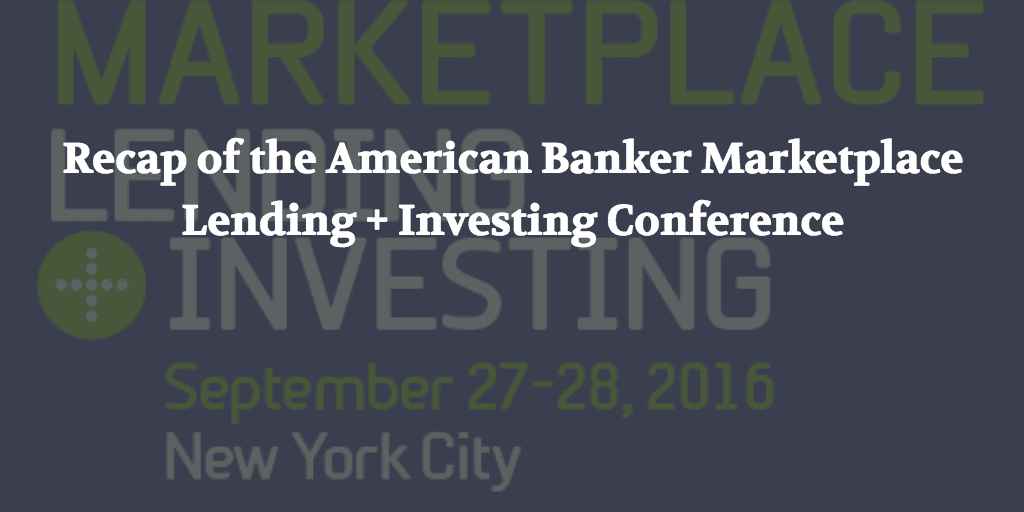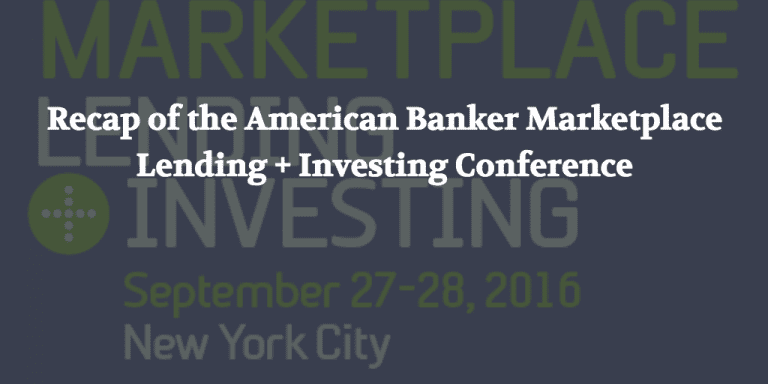
I spent the week in NYC and attended the American Banker’s Marketplace Lending + Investing event organized by Source Media. Many familiar faces were in the crowd at this years event and the content touched on many of the hot topics in the marketplace lending industry today, namely regulation, transparency, partnerships and access to capital. In this post I’ll share session highlights from the event.
The conference kicked off with Anthony Hsieh, CEO and Co-Founder of loanDepot. loanDepot is a company that I only became aware of late last year, but they are a big player in online lending. The company has been in operation for almost 7 years and has originated $10 billion in Q2, 2016 comprised mostly of their mortgage offerings. The company has now originated $87 billion in loans.
Anthony shared a few points on how the industry is well poised for growth. When looking at consumer credit demand trends since 2008, there is a steady decline coming out of the recession until 2012. Since then, demand has been on the rise. We’ve also seen a shift in how consumers access credit. Historically, borrowers have used home equity as a way to fund their lifestyles, but now this has shifted to products like the unsecured loan. It remains to be seen whether or not we will see demand shift back to HELOCs as a way for consumers to access affordable credit.
He went on to share just how fragmented the private mortgage lending space is. A majority of loans made today are going to both Freddie and Fannie. This marks an opportunity for specialty lenders and as Anthony pointed out, their challenge isn’t customer demand. The challenge is creating the products, focusing on conversion and tech enabled processes. Anthony believes the digital mortgage industry is just getting started, citing opportunities in areas like property appraisals and accessing data to improve efficiency.
Peter Renton moderated a panel discussion on the past, present and future of marketplace lending with Noah Breslow of OnDeck, Jim McGinley of Insikt, Gilles Gade of Cross River Bank and Sam Hodges of Funding Circle. The discussion centered around funding, regulation and bank partnerships. Here are a few bullet points from that discussion:
- Noah Breslow said the OnDeck/Chase partnership is going well. The hybrid model proved beneficial due to capital markets tightening this year.
- Funding Circle doesn’t feel pressure from investors to own loans on their balance sheet.
- Loan stacking is an issue and the mid to long term solution is to work with platforms, but there are challenges in that approach.
- Companies across the board are investing for growth and focusing on unit economics as opposed to achieving profitability. However, Funding Circle expects to be profitable next year.
Last year has brought many industry associations into the mix. We heard from several of the associations that exist today and heard the differences between them. This will be an interesting topic to watch over the next year as the newer associations begin to mature and become more inclusive in the companies that they allow to be a part of the association. The panel shared that there needs to be more industry collaboration around disclosure and anti-stacking policies.
Several other sessions also expanded on regulation. There are currently 15 regulatory schemes that touch marketplace lending, which makes it an important topic. One key takeaway for me was that companies should do what they believe regulators would want them to do despite what existing rules may be in place. Companies who do this right, will do well once regulations are implemented. They will have a competitive advantage over their peers. It’s important to remember that these new businesses can’t innovate their way around regulation.
For the first time we heard Goldman Sachs’ speak publicly about their unsecured lending product called Marcus that will be launching this fall in an interview between Stephen Scherr (Chief Strategy Officer & Chief Executive Officer, GS Bank USA) and Kevin Wack (Consumer Finance Reporter, American Banker). We learned that Goldman Sachs had explored entering the market through an acquisition, but were put off by high valuations. Although there wasn’t any groundbreaking news, this article from the Wall Street Journal has the summary of the discussion.
Another interesting session was “Bringing the Secondary Market to Life”, a discussion between Matt Burton (Orchard) and Larry Chiavaro (First Associates). A secondary market is something that has been talked about for quite some time and it’s clear that it has been a challenge for the team at Orchard. However, Orchard plans to release it in the fourth quarter of 2016 and he shared some of the challenges with the audience. The main challenge for Orchard was that there was no set regulatory path for them as they sought to build out the secondary market. For two years they have been getting conflicting feedback from various regulators. It eventually became clear that moving forward as a broker-dealer was the right approach.
The other challenge is getting buy-in from all parties involved. Platforms and originators have to agree to participate and there are considerations from their perspective on aspects of their business surrounding settlements and clearing. The other question is who are the liquidity providers for the secondary market. Although this is a complex problem it sounds like Orchard has been making progress. A secondary market could bring many benefits to this industry including the possibility of launching an ETF. Matt Burton also noted that cash drag is an issue which the secondary market can also help with.
We also heard from Lending Club CEO Scott Sanborn who highlighted where we’ve been, where we are today and where we are headed as an industry. Approximately 24% of personal loans are now made online, with Lending Club continuing to be the number one provider despite the recent declines in originations. One attendee asked Scott whether they intend to evolve into a hybrid model. Scott said they have talked about using their own capital to bridge funding gaps and subsequently selling these loans to investors once funding demand returns. They continue to use their own capital for new programs to demonstrate skin in the game to prove out the new program, but Scott said that they don’t plan a broader pivot in their funding model, noting that they’ve been competing with deep pocketed players since they’ve started.
Conclusion
Not surprisingly the focus of the conference was more about stabilization and sustainability as opposed to growth. Companies are looking for ways to improve their businesses to really position themselves for the long haul. It certainly is going to be interesting to see what happens between now and when the industry meets next March at LendIt USA.


